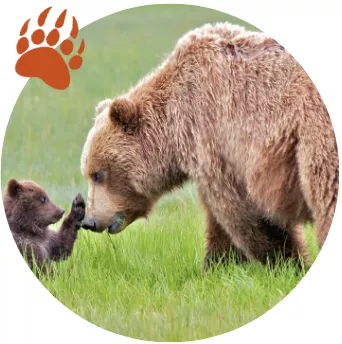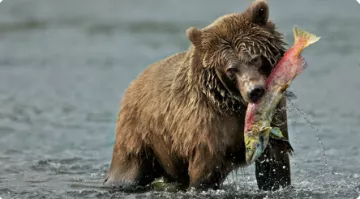Grizzly Bears Still Need Federal Protection
Join our Wildlife Justice Team!
Background

Grizzly bears are an essential piece of the American West, a wildlife icon that has been integral to the Yellowstone region for centuries. They embody true wilderness.
In the late 19th and early 20th century, grizzly bears were nearly wiped out in the lower 48 states. An estimated 50,000-100,000 grizzlies throughout the West were reduced to 800 by unregulated killing, bounties, habitat destruction and fragmentation. Through diligent work and the protections of the federal Endangered Species Act (ESA), grizzlies have come back mostly in Yellowstone and Glacier National Parks and surrounding wildlands. Today there are an estimated 1,900 bears in the Northern Rockies, and they are slowly expanding into suitable habitats in some areas. But the job of recovering grizzlies is far from done, as continued development, more human presence and hostile state legislatures and wildlife officials work to keep grizzlies in isolated populations, with bare minimum numbers.
Grizzly Bear Populations Remain Dangerously Low

Elected officials and appointees in Wyoming, Idaho and Montana are working to remove federal ESA protections for grizzlies that will hinder their continued recovery and allow for more killing of bears, both by ranchers and through the return of grizzly bear trophy hunts. This is not the time to undo decades of hard conservation work that has led to the rebounding of one of the slowest reproducing species in the world. Grizzlies must remain protected and conservation efforts must continue as we work for real, long-term grizzly recovery. Consider:
- They are the second slowest reproducing mammal in North America, and among the slowest reproducing species worldwide. It takes a female grizzly bear ten years to replace herself in the population.
- Grizzlies in the Yellowstone region have been both geographically and demographically isolated from other bear populations for 100 years. Existing state management plans don't allow them to connect to other grizzly populations–we must develop plans that do.
- Today there are only two populations in the lower 48–the Greater Yellowstone and Northern Continental Divide ecosystems. Despite progress in recovering grizzly bears, now is not the time to remove protections.
These anchor populations are essential to long-term grizzly bear recovery in and between all of the recovery areas. Currently, there are only 50-60 bears in the Cabinet-Yaak recovery area, and no resident grizzly bears at all in the Bitterroot – a vast recovery area of millions of acres of designated wilderness spanning Idaho and Montana.
We must continue the hard work to allow this magnificent species to fully recover, including re-establishing a population in the Bitterroot and achieving natural connectivity between grizzly bear populations in the Northern Rockies.